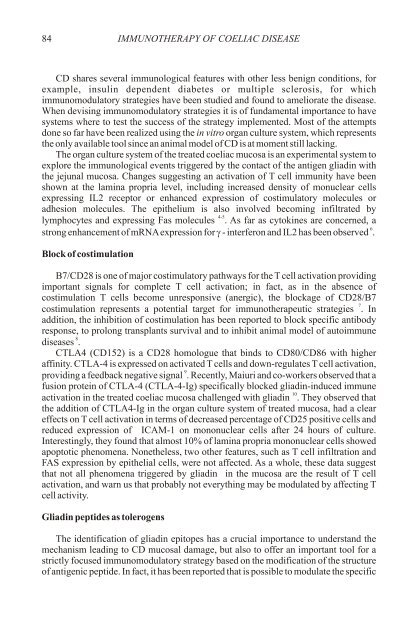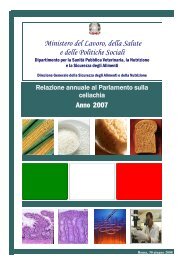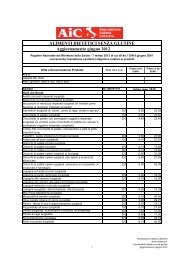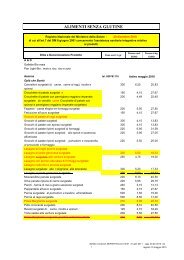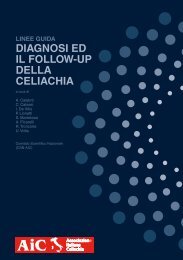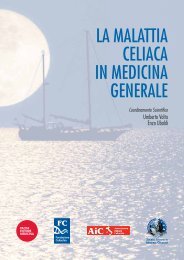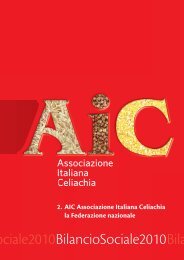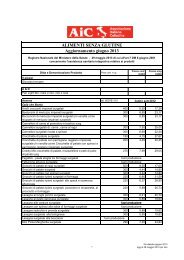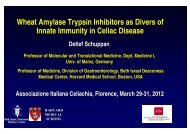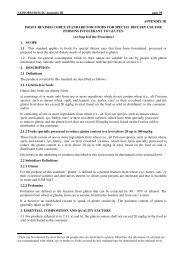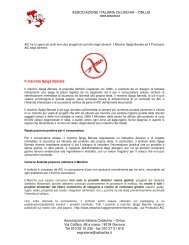primary prevention of coeliac disease - Associazione Italiana ...
primary prevention of coeliac disease - Associazione Italiana ...
primary prevention of coeliac disease - Associazione Italiana ...
You also want an ePaper? Increase the reach of your titles
YUMPU automatically turns print PDFs into web optimized ePapers that Google loves.
84<br />
IMMUNOTHERAPY OF COELIAC DISEASE<br />
CD shares several immunological features with other less benign conditions, for<br />
example, insulin dependent diabetes or multiple sclerosis, for which<br />
immunomodulatory strategies have been studied and found to ameliorate the <strong>disease</strong>.<br />
When devising immunomodulatory strategies it is <strong>of</strong> fundamental importance to have<br />
systems where to test the success <strong>of</strong> the strategy implemented. Most <strong>of</strong> the attempts<br />
done so far have been realized using the in vitro organ culture system, which represents<br />
the only available tool since an animal model <strong>of</strong> CD is at moment still lacking.<br />
The organ culture system <strong>of</strong> the treated <strong>coeliac</strong> mucosa is an experimental system to<br />
explore the immunological events triggered by the contact <strong>of</strong> the antigen gliadin with<br />
the jejunal mucosa. Changes suggesting an activation <strong>of</strong> T cell immunity have been<br />
shown at the lamina propria level, including increased density <strong>of</strong> monuclear cells<br />
expressing IL2 receptor or enhanced expression <strong>of</strong> costimulatory molecules or<br />
adhesion molecules. The epithelium is also involved becoming infiltrated by<br />
4-5<br />
lymphocytes and expressing Fas molecules . As far as cytokines are concerned, a<br />
6<br />
strong enhancement <strong>of</strong> mRNA expression for g- interferon and IL2 has been observed .<br />
Block <strong>of</strong> costimulation<br />
B7/CD28 is one <strong>of</strong> major costimulatory pathways for the T cell activation providing<br />
important signals for complete T cell activation; in fact, as in the absence <strong>of</strong><br />
costimulation T cells become unresponsive (anergic), the blockage <strong>of</strong> CD28/B7<br />
7<br />
costimulation represents a potential target for immunotherapeutic strategies . In<br />
addition, the inhibition <strong>of</strong> costimulation has been reported to block specific antibody<br />
response, to prolong transplants survival and to inhibit animal model <strong>of</strong> autoimmune<br />
8<br />
<strong>disease</strong>s .<br />
CTLA4 (CD152) is a CD28 homologue that binds to CD80/CD86 with higher<br />
affinity. CTLA-4 is expressed on activated T cells and down-regulates T cell activation,<br />
9<br />
providing a feedback negative signal . Recently, Maiuri and co-workers observed that a<br />
fusion protein <strong>of</strong> CTLA-4 (CTLA-4-Ig) specifically blocked gliadin-induced immune<br />
10<br />
activation in the treated <strong>coeliac</strong> mucosa challenged with gliadin . They observed that<br />
the addition <strong>of</strong> CTLA4-Ig in the organ culture system <strong>of</strong> treated mucosa, had a clear<br />
effects on T cell activation in terms <strong>of</strong> decreased percentage <strong>of</strong> CD25 positive cells and<br />
reduced expression <strong>of</strong> ICAM-1 on mononuclear cells after 24 hours <strong>of</strong> culture.<br />
Interestingly, they found that almost 10% <strong>of</strong> lamina propria mononuclear cells showed<br />
apoptotic phenomena. Nonetheless, two other features, such as T cell infiltration and<br />
FAS expression by epithelial cells, were not affected. As a whole, these data suggest<br />
that not all phenomena triggered by gliadin in the mucosa are the result <strong>of</strong> T cell<br />
activation, and warn us that probably not everything may be modulated by affecting T<br />
cell activity.<br />
Gliadin peptides as tolerogens<br />
The identification <strong>of</strong> gliadin epitopes has a crucial importance to understand the<br />
mechanism leading to CD mucosal damage, but also to <strong>of</strong>fer an important tool for a<br />
strictly focused immunomodulatory strategy based on the modification <strong>of</strong> the structure<br />
<strong>of</strong> antigenic peptide. In fact, it has been reported that is possible to modulate the specific


